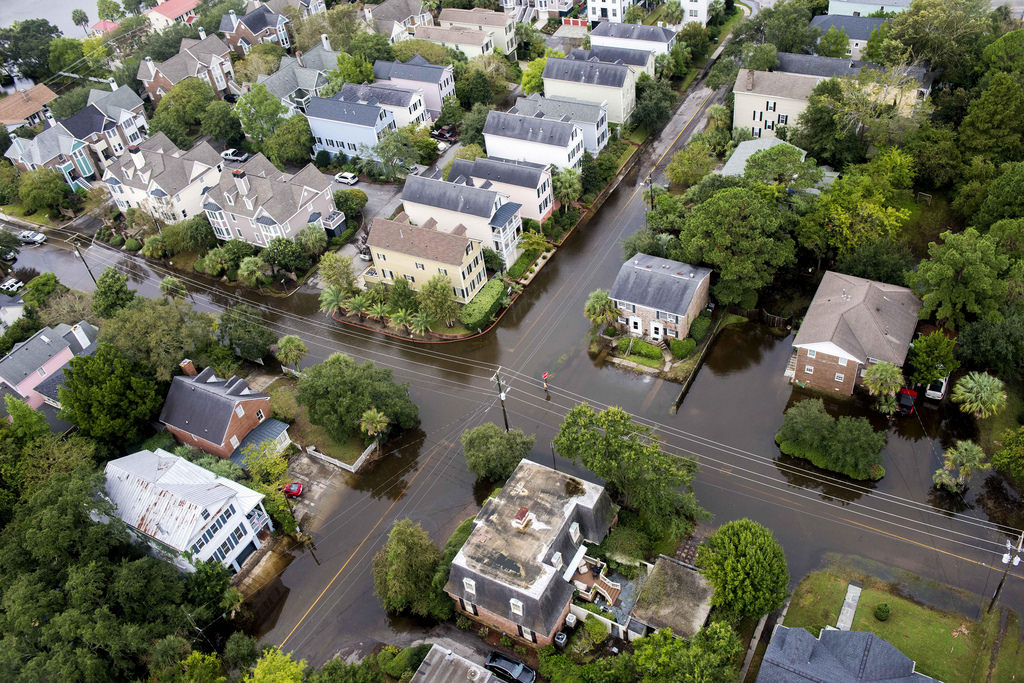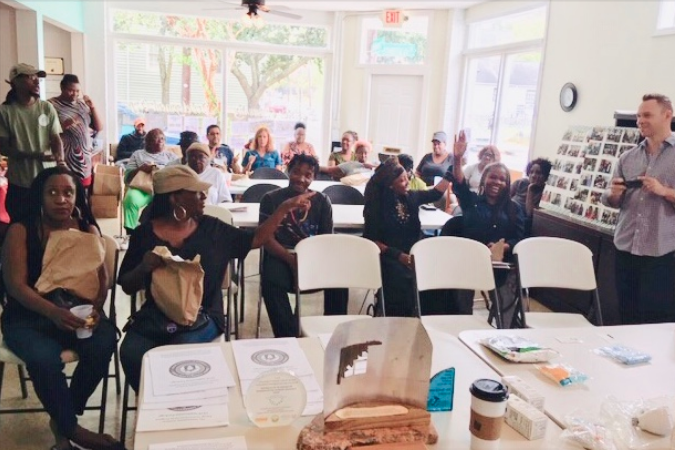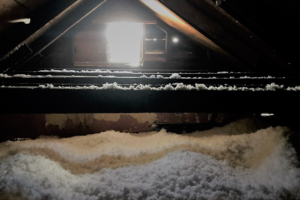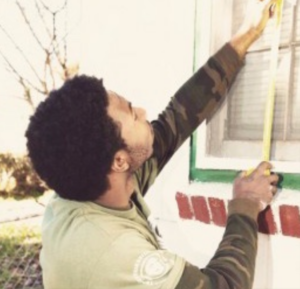Adapting Climate Approaches in a Changing Charleston, South Carolina, Neighborhood

Something New to Preserve the Old
Latonya Gamble looks out the window of Eastside Community Development Corporation’s headquarters, just north of Charleston’s bustling tourist district. She sees a range of historic homes in various stages of repair and renovation. Long-time homeowners in this historically African-American community now live alongside college-student rentals owned by absentee landlords and newly renovated houses that are prized by wealthy buyers. These arethe signs of a historic neighborhood that is undergoing — for better or worse — an influx of change.
But Latonya also sees her home in Charleston — the place where she grew up, raised her own children, and loves to return to after every trip as an international flight attendant. She’s happy to welcome new neighbors, but is very mindful that keeping her neighborhood safe and welcoming for all means paying attention to the needs of lower income residents. This includes the cost of heating and cooling inefficient homes as well as protecting them from flooding caused by sea level rise and climate change.
It’s a lot to take on, but fortunately Latonya won’t be addressing this problem alone.
Sometimes preserving the best of something old means trying something new. In a city like Charleston with deep cultural roots and more historic buildings than you can count, the effects of growth on neighborhood preservation and the growing impacts of climate change demand a new approach that can address both issues simultaneously. That’s a challenge that the City of Charleston and the nonprofit Sustainability Institute are working together to meet.

Charleston’s Eastside neighborhood is filled with historic homes – some struggling with maintenance and repair issues, and others freshly renovated by wealthy new neighbors. This 32-square-block neighborhood was home to one of the country’s largest settlements of free black tradesmen and craftsmen before the Civil War, and has remained predominantly African-American since then, despite off-and-on battles with poverty and crime. Now, as Eastside has been “discovered” by developers and new residents, those born and raised there have concerns about maintaining the culture and integrity of their neighborhood. For the City of Charleston, concerns about climate change have galvanized an interest in increasing energy efficiency and protection from flooding.
“Charleston has experienced three major storms in recent years,” says Katie McKain, Director of Sustainability for the City of Charleston. “We need to explore ways to adapt to increasing risks, and a lot of it is structural, such as innovative flood-proofing techniques. There are many storm-threatened properties in Eastside. We’re looking for ways to preserve these structures and adapt to sea level rise at the same time. We really need to work cooperatively as a society and community to help achieve solutions. And we really need strategic partnerships.”
“We are a small, grassroots organization that’s trying to make a difference in our neighborhood… the neighborhood is changing and there’s a lot still to be done… so we want to make sure we’re at the forefront and get our fair share.”
— Latonya Gamble, President of Eastside Community Development Corporation, Charleston, South Carolina
One such partnership has arisen with the nonprofit Sustainability Institute through a $150,000 grant from the Southeast Sustainable Communities Fund (a project of the Southeastern Sustainability Directors Network and The Kendeda Fund, with support from Merck Family Fund). With this funding, the partners will test solutions like weatherization, solar power, and flood-proofing for Eastside’s low-income homeowners. While the City and Sustainability Institute have worked together in many ways over the past two decades, the project provides an opportunity to come at age-old challenges in a different way.
Start with What You Know in Charleston
Trying something new means building new partnerships, and building trust in a neighborhood that has learned not to be trusting. Both require time and a shared vision.
For Sustainability Institute, starting work in Eastside means starting with what they know best —weatherization. Executive Director Bryan Cordell and his staff reached out to Latonya Gamble, president of Eastside Community Development Corporation (ECDC), a nonprofit that serves as the neighborhood association for Eastside. ECDC tackles myriad issues in the neighborhood, from parks to public art, from parking to community safety, and ultimately to providing more opportunities for residents young and old.
“We’re a small, grassroots organization that’s trying to make a difference in our neighborhood,” says Gamble “The neighborhood is changing and there’s a lot still to be done. For a very long time our neighborhood has always been passed by. We got resources but not as much as we should have been receiving. So, we want to make sure that we’re at the forefront and get our fair share.”
“It’s a much more intense focus on the neighborhood. Yes, we’re doing weatherization and energy efficiency work, but we’re also… trying to empower residents to do things on their own.”
— Bryan Cordell, Director of Sustainability Institute
Together, Cordell and Gamble determined that weatherization work would be the best place to start, and agreed that Sustainability Institute’s team could begin with a three-fold approach: 1) conduct a series of community education workshops; 2) do door-to-door outreach to find and encourage low-income home owners to welcome free weatherization; and 3) weatherize ECDC’s historic, two-story structure as a community demonstration project.

In the fall of 2018, Sustainability Institute completed an energy upgrade retrofit of the ECDC building and began doing outreach. At its first community workshop, some 25 local families learned what they could do to improve energy efficiency in their own homes, and about the free weatherization and upgrade services available from the Sustainability Institute. Each family left the workshop with do-it-yourself energy-saving supplies, such as caulking tools, LED lightbulbs, weather stripping, and more. Cordell and his team plan to touch base periodically with all workshop attendees to determine whether they’ve used the supplies and the energy savings they’ve seen as a result.
Since that workshop, Sustainability Institute has conducted several energy assessments in Eastside and completed its first residential retrofit for an elderly, long-term resident. Working with the elderly is particularly important, says Gamble, because they are often unaware of the impact they’re having on the environment or their own pocketbooks.
“I really would like to start with the elderly persons in our community because they have fixed incomes,” she says. “Energy upgrades and retrofits would make their houses safer for them, warmer in the winter time and cooler in the summer. We have residents like Mr. Oscar who just turned 100, Ms. Gladys who turned 93, and Ms. Davis who turned 92, so we have some people who are really elderly. I think they feel that they don’t use that much energy. But I explain to them that they could have little cracks or other places where they could be losing energy.”
“We’ve now started intense outreach to find homes that we can work on and to better engage families,” says Cordell. “Our goal is 15 houses for full retrofits in Eastside this year. For five of those we’ll do the solar and flood-proofing, too. Then hopefully there’s another 15 to 20 that get light weatherization work. We’ll work closely with Latonya to understand house by house what the situation is, who’s living there, and what their needs are, making sure that we’re serving the low-income, owner-occupied homes.”
As with many historic houses, the need for structural or safety repairs can sometimes impede the ability to conduct energy upgrades. To help with this, Sustainability Institute has approached other area partners that have the skills and manpower to address things like water damage, mold and other issues to bring homes up to standard.

“As we retrofit homes, we’re going to try to put together other types of interventions in each house,” says Cordell. “We’re trying to bring other resources to the neighborhood that we haven’t in the past, like critical home repair. So, it’s a much more intense focus on the neighborhood where yes, we’re doing weatherization and energy efficiency work, but we’re also doing a whole lot of community outreach, trying to empower residents to do things on their own, and bringing resources from other organizations to do home repair work. It’s a much more intense effort than anything we’ve done in the past.”
Although the solar and flood-proofing work are still to come, the City’s McKain sees the weatherization and outreach as an early win. “Reducing emissions is a huge part of mitigating climate change,” says McKain. “A key component to supporting energy upgrades is that it not only helps residents and reduces their costs, but also reduces the demand on energy. That’s a win-win for everyone.”
Cordell, Gamble, and McKain agree that the work in Eastside can only proceed at the speed of trust, and they are making a point of investing the time to build it.
“At first the community did not trust them,” says Gamble about Sustainability Institute. “Gaining their trust was not an easy task because ours is a community where a lot of people promise a lot of things but we get very little out of those promises. That’s why the process took a good year [to get off the ground]. Once we had a series of meetings and we explained the process, I think [the residents] felt a little bit better because they kept coming back.”
“It’s difficult work, but it’s all about trust and communication,” McKain observes. “That makes it helpful to have nonprofit partners like Sustainability Institute and ECDC to collaborate with and together help residents have more resilient homes.”
Homegrown Human Capital
When he’s not at his full time job as a fireman in North Charleston, running his fledgling insulating company, or spending time with his wife and 8-year-old son, Kedrick Wright oversees a team of AmeriCorps Energy Conservation Corps (ECC) participants from Sustainability Institute as they conduct energy audits and weatherization activities on homes in Charleston’s Eastside. Kedrick himself graduated from the ECC ten years ago, but happily serves as a site supervisor and mentor to current participants.
Wearing Tyvek suits and appropriate safety gear, Kedrick’s crew moves through the house of an elderly resident, including the crawl space and attic. They test for air leaks, do weather sealing, insulating, and replacement and repair of duct work, among other energy upgrades. But Kedrick also shares life lessons and advice as a trusted mentor for his team.
“We discuss a lot of life issues,” he says. “If they have any questions about, buying a house, or parenting, or other things, I’m not an expert, but I can give them examples of where I might have felt like I messed up or I could have done better and tell them, ‘Hey, this is something you could do or try.’ When I was in this program, I learned from somebody that was close to me and had my best intentions in mind, so why not pass that on? You don’t have to be that leader who stands on a soapbox every day, but in instances where you see people need help, then help. I think that would change things drastically if everybody took that approach.
”At the heart of the Sustainability Institute’s success is a focus on providing workforce development for green jobs and careers. It’s one aspect of the program that helped gain trust in Eastside.
“We’ve always felt that serving the at-risk populations and getting them trained and certified and placed in jobs is the heartbeat of our organization,” says Cordell. “Our focus from the start was at-risk young adults, particularly vulnerable kids who were in all kinds of different situations, most of them either had been incarcerated or were in some kind of situation of crisis, living in challenged neighborhoods with challenged families.”
The Sustainability Institute’s job readiness work eventually became part of the AmeriCorps Energy Conservation Corps (ECC) – and the first AmeriCorps program in the country to focus on energy upgrades for low-income people.
The program includes soft skills and industry training, providing participants (usually 12-16 men but also the occasional woman) with a robust combination of work and personal skills that enable them to land jobs as contractors, energy auditors, or whatever they desire in the industry and to thrive in a professional environment. During the six-month, 900-hour program, participants go into homes to learn, hands-on, the ins and outs of weatherization and energy efficiency upgrades. Each earns a standard AmeriCorps bi-weekly $300 stipend as well as $3,000 to further their education. Participants can re-enroll for up to four terms, for a total of two years’ training and mentoring and as much as $12,000 for education.
ECC Program Director Larry Bratton runs the program as if the participants were his own family, and serves as a father to many. While some ECC members come into the program in relatively stable situations, others battle homelessness, hunger, health, and transportation challenges to make it through.
“We teach them our ways, the skills sets and the ethics and integrity,” says Bratton. “We go in people’s homes and we’re all over their house for three or four days. And when we leave, the house is weatherized and not one thing is missing. Then, some of the same young people that made those houses warm, go home to houses where there may be cardboard on their window and no heat. And still they show up every day to make a difference in someone else’s life.”
Bratton recalls one participant who had multiple children with different mothers, no driver’s license, and outstanding misdemeanor charges.
“Now his life has changed,” says Bratton. “He’s got a house, just had another baby and is getting married, holding down a job, and working all over the region leading a team for an insulation company. When we can, we put him on the phone to talk to others in the program.”
“We’ve created a safe place,” Bratton continues. “Many of these young people didn’t have that with their local environment, in their home. They had a lot of instability. Now they’ve got mentors, they’ve got trainers, they’re learning stuff new every day, they’re giving back in the community, and they feel good that they’re contributing.”
Bratton also creates job shadowing and mentoring opportunities, facilitating relationships with future employers in the area or beyond. These aren’t just local connections with peers, but first-hand connections with company owners across the country in just about any career field that is of interest to participants.
“We make sure our people have access to things and leaders they normally wouldn’t have,” says Bratton. “We’d love for them to stay in the weatherization field, but what we really try to do is get them skill sets and exposure to see beyond the walls so they can do more.”
“A lot of times issues with crime and just miseducation of people within inner cities can be ratified by just introducing job opportunities, introducing wealth, or introducing opportunities for them to change those aspects that they’re in right now,” says Kedrick Wright, a former ECC member who now serves as a site supervisor for ECC crews. “We’re offering them the opportunity to work along with contractors and become contractors themselves and get a piece of this massive green jobs market that’s coming into Charleston right now.”
Innovating for a Sustainable Future Charleston
Creating a skilled workforce is part of the sustainability solution, but Cordell is also interested in increasing demand for energy efficiency among consumers in Eastside and beyond Charleston. One way to do that for low-income homeowners is to identify innovative, alternative methods of financing energy audits and upgrades.
“This is an opportunity to see what works. Anything we can do to help residents have more resilient homes, that’s a good thing for us because house by house, we become a more resilient city.”
— Mark Wilbert, Chief Resilience Officer, The City of Charleston
“The biggest barrier in general for doing energy upgrades is the upfront cost,” he explains. “Just having an independent, certified energy auditor come out and evaluate what needs to be done can cost between $600 and $1,000. That’s more than most low-income families can afford. So, we’re exploring the possibility of working with a financial partner to establish a revolving loan fund, or create new ways for low-income customers to work with area banks to gain access to credit for energy audits and upgrades. We know this might be challenging, since many of the families won’t meet standard credit score or collateral requirements. But on the other hand, the average cost savings for the weatherization work we do is about 20% for homeowners, and that’s money that could pay back an energy efficiency loan in a relatively short amount of time.”
Innovations in Eastside can also seed and spread citywide.
“This is an opportunity to see what works,” says Mark Wilbert, Charleston’s Chief Resilience Officer. “Anything we can do to help residents have more resilient homes, that’s a good thing for us because, house by house, we become a more resilient city. If there are low cost opportunities that work in the Eastside, maybe there are things we can apply in similar neighborhoods and go after additional funding to make solutions more available throughout Charleston.”
It’s a Saturday morning in Eastside, and LaTonya introduces Bryan Cordell and his team to a gathering of about 30 residents. For the next hour they talk about energy efficiency, weatherization, and cost savings. Each homeowner leaves with a do-it-yourself kit to begin home energy upgrades on their own. Others sign up for free energy efficiency audits. Slowly, the neighborhood is beginning to see the value of the work to reduce their energy consumption —not just to cut energy bills and live more comfortably in their own homes, but to preserve the history and culture of their community.
The Southeast Sustainable Communities Fund (SSCF) awards grants to local partnerships in the southeastern United States to advance local government policies and programs that will create equitable and sustainable energy and water initiatives. SSCF is a partnership between The Kendeda Fund, The Kresge Foundation and the Southeast Sustainability Directors Network (SSDN).
For more information please visit www.southeastsdn.org.
Contact: Meg Jamison, meg@southeastsdn.org
All images are used with permission from Sustainability Institute, The City of Charleston and Department of Defense and U.S. Coast Guard — Photo of flooding post Hurricane Joaquin, 2015, Photo by: Petty Officer 1st Class Stephen | VIRIN: 151005-G-BD687-495.JPG (page 1)